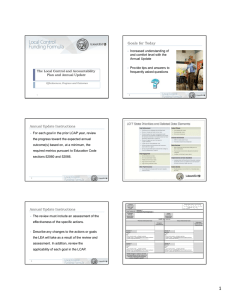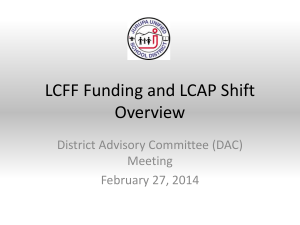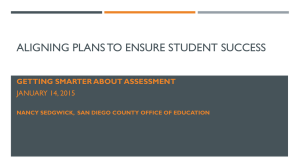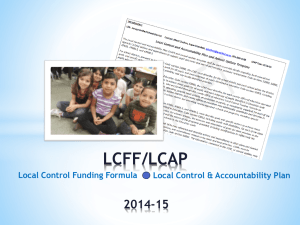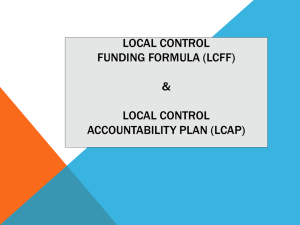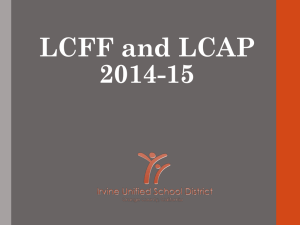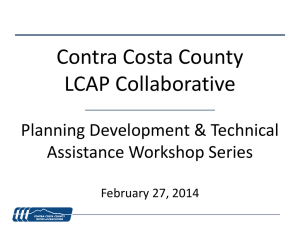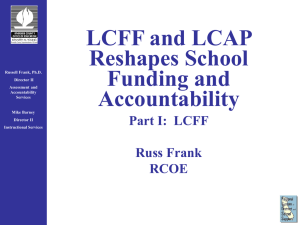Documents & Forms - LCAP PowerPoint February 21
advertisement
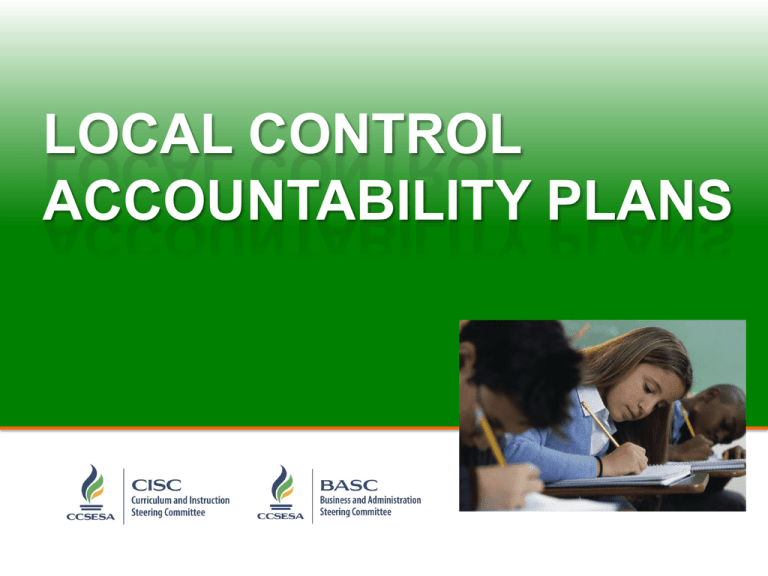
LOCAL CONTROL ACCOUNTABILITY PLANS 1 Focus for Today’s Work • Local Control Funding Formula (LCFF) - Shifts in Thinking and Funding • Local Control Accountability Plan (LCAP) Development – Section 1: Stakeholder Engagement – Section 2: Goals and Progress Indicators (including State Priorities) – Section 3: Actions, Services, and Expenditures • Ties to Other Plans • LCAP Adoption Process • E-LCAP 2 LOCAL CONTROL FUNDING FORMULA Shifts in Thinking and Funding $ $ $ $ $$ $ $ $ $ $ $$$$$$$$$$$$$$$$$$$$$$$$$ $ 3 $$ $ 3 Local Control Funding Formula • Historic reform to education funding • Redistribution of funds • Funding based on grade level grants and demographic data for each district • Funding targets will be phased in over an estimated 8-year period • Creates new accountability for how all students are served, and in particular, sub-groups 4 How is LCFF different from what was in place under revenue limits? • Simplifies funding • Revenue limits and most state categoricals are eliminated • Districts, county offices of education, and charter schools will receive funding based on the students they serve, with greater flexibility to use these funds to improve outcomes of students • Assumes continued state economic growth 5 LINK to LAO Overview: http://www.lao.ca.gov/reports/2013/edu/lcff/lcff-072913.pdf LINK to CDE’s FAQ: http://www.cde.ca.gov/fg/aa/lc/lcfffaq.asp Revisiting the Local Control Funding Formula (LCFF) ADJUSTMENTS Grade Level Per Student Base Amount Demographics (Low income, English Learner, and/or Foster Youth) 6 This slide shows images that illustrate how the Local Control Funding Formula works. LCFF provides the same amount of funding per student with two adjustments (1) grade level and (2) demographics. Taken from a WestEd Presentation $ Overview of LCFF Districts and Charter Schools 7 Formula Component Rates/Rules Target base rates (per ADA) K-3 = $6,952 4-6 = $7,056 7-8 = $7,266 9-12 = $8,419 Base rate adjustments K-3 = 10.4% of base rate 9-12 = 2.6% of base rate Supplemental funding for EL/LI/FY 20% of adjusted base rate Concentration funding Each EL/LI student above 55% of enrollment generates an additional 50% of adjusted base rate Add-ons Targeted Instructional Improvement Block Grant, Home-to-School Transportation, Economic Recovery Target Portion of LCFF Increase to be used for Identified Students GAP Increase in funding attributable to Unduplicated Count SUPPLEMENTAL/ CONCENTRATION GRANTS GAP FUNDING (Est. 28% of Gap) BASE AND AUGMENTATION GRANTS 2013-14 Funded LCFF 8 2014-15 LCFF TARGET 2013-14 FUNDING 2014-15 FUNDING Certification of Student Data • SB 97 requires COEs to “review and validate reported English learner, foster youth, and free or reduced-price meal eligible pupil data for school districts and charter schools under its jurisdiction to ensure the data is reported accurately.” • To assist COEs, CALPADS will include school-level reports that display the aggregate unduplicated counts of disadvantaged students for each district and charter school within the county. • Fall 1 certification deadlines were mid-December 2013. Close of amendment window will be March 21, 2014 9 Supplemental/Concentration Grant Funds Supplemental and Concentration Grant Funds are generated by the number of English Learner (EL), Low Income (LI) and Foster Youth (FY) students in the district, charter, or county office of education. Collectively, these students are referred to as “unduplicated pupils” in the statute and regulations. Regulations adopted by January 31, 2014: – Will require district, county office of education or charter to “increase or improve services for EL/LI/FY pupils as compared to the services provided to all pupils in proportion to the increase in funds apportioned on the basis of the number and concentration of unduplicated pupils.” 10 Definition of Services “Services” as used in Education Code section 42238.07 may include, but are not limited to, services associated with the delivery of instruction, administration, facilities, pupil support services, technology, and other general infrastructure necessary to operate and deliver educational instruction and related services. 11 Proportionality Percentage Estimates • The State Board of Education provides regulations that describe the methodology of determining the proportional increase or improvement in services for unduplicated pupils. • LEAs will estimate their proportion using current and accurate local enrollment projections performed in the spring for use in their LCAP adoption process. – ADA, by grade level – Total enrollment – Total unduplicated pupils 12 Calculating the Proportionality Percentage For Districts and Charters, begin with the LCFF projected revenues (excluding Transportation and TIIG): • Calculate the estimated 2014-15 LCFF Funding Target • Calculate the estimated 2014-15 Total LCFF Funding 13 Calculating the Proportionality Percentage 1. Calculate the LCFF supplemental and concentration grant targets, at full implementation 2. Determine prior year expenditures to support unduplicated pupils. No less than the amount of EIA expended in 2012-13 3. Subtract the estimated 2013-14 expenditures from the supplemental and concentration grant target. 4. Multiply the difference by the gap percentage funding for the year in which the LCAP is adopted (funded portion of increase in funding generated by unduplicated count) 14 Calculating the Proportionality Percentage (continued) 5. 6. 7. 8. 15 Add to the LEA’s prior year estimated expenditures from step 2 (total amount of LCFF funding identified for use for unduplicated count) Subtract the amount in step 5 from the total LCFF funding in 2014-15 (total amount of LCFF funding available for use for all students) Divide the approximate amount from step 5 by the amount in step 6 (the Proportionality Percentage, the % that must be used to improve or increase services for the unduplicated count over what is provided to all students) When the LCFF is fully implemented statewide (or if your prior year’s expenditures equal or exceed the funded S&C Grants), then the Proportionality Percentage is the total S&C grants divided by the remainder of the LCFF funding, excluding add-ons for TIIG and H-S Transportation. Sample District • • • • • • 16 Unified School District ADA – 20,000 Unduplicated Count – 57% 2012-13 EIA - $2.4 million Total Est. 2014-15 LCFF Funding - $134.3 million 2014-15 Gap Funding – 28.05% 16 Sample Proportionality Percentage Calculation of Proportionality Sample Calculations for Six Districts Calculation Percentage STEP DESCRIPTION 1 Total Target S&G Grant at Target $19,600,000 2 Spent on identified students last year $2,400,000 3 Difference? 4 Funded portion of the increase in the S&G Grants $4,825,000 5 Amount that must be spent on identified students $7,225,000 6 Amount available to support all students 7 Proportionality Percentage $17,200,000 $127,075,000 5.69% 17 Important Considerations • The amount of revenue limit and categorical funds in 2012-13 is the starting point for LCFF. – No LEA will receive less than this amount. • Total revenues received will fluctuate proportionate to changes in ADA and changes in unduplicated pupils. • Full implementation of LCFF is estimated to occur over an 8-year period. 18 LOCAL CONTROL ACCOUNTABILITY PLANS Development Process $$$$$$$$$$$$$$$$$$$$$$$$$ 19 19 LCAP Template Instructions • Use guiding questions as prompts for completing the information as required by statute. – Guiding questions do not require separate narrative responses. • Data referenced in the LCAP must be consistent with the school accountability card where appropriate. 20 20 The Three LCAP Elements SECTION 1: STAKEHOLDER ENGAGEMENT SECTION 2: GOALS AND PROGRESS INDICATORS SECTION 3: ACTIONS, SERVICES, AND EXPENDITURES 21 LCAP Template for Section 1 Involvement Process Impact on LCAP Describe the process used to engage stakeholders and how this engagement contributed to development of the LCAP 22 Section 1: Stakeholder Engagement A governing board of a school district shall consult with teachers, principals, administrators, other school personnel, local bargaining units of the school district, parents, and pupils in developing a local control and accountability plan. [EC 52060(g)] 23 Definition of “consult” The determination of curriculum content, the selection of instructional materials, and the use of instructional technology are subject to the duty to "consult" under Government Code Section 3543.2(a). "Consultation" (also known as "meet and confer") involves the free exchange of information, opinions, informal proposals, and recommendations according to orderly procedures in a conscientious effort to incorporate such recommendations into the resulting policy or plan. 24 The Fiscal Report (2013) School Services of California, Inc. Obligation to “negotiate” While LEAs have an obligation to "consult," they do not have an obligation to "meet and negotiate" implementation decisions. "Establishing educational policies, goals and objectives," "determining curriculum," and "establishing budgetary priorities and allocations" are all fundamental management prerogatives not within the mandatory scope of bargaining… 25 The Fiscal Report (2013) School Services of California, Inc. Obligation to “negotiate” (continued) However, if such decisions would have a foreseeable impact on negotiable "terms and conditions of employment" for bargaining unit members, a school district or COE is required to negotiate the "effects" or "impacts" of these decisions on negotiable subjects, including for example, hours of employment and compensation for professional development. 26 The Fiscal Report (2013) School Services of California, Inc. Required Representation from Parent Groups Parent Advisory Committee Low Income rep EL Parent Advisory Committee 15% ELs and Foster Youth rep English Learner rep 27 At least 50 EL pupils Members of pre-existing committees (ELAC/DELAC) can be included in the LCAP EL Parent Advisory Committee. Classification of Students for LCFF English Learners (EL) Low Income (LI) • Based on Home Language Survey and California English Language Development Test (CELDT) • No time limit for funding • Reclassified students (Fluent English Proficient) will no longer generate additional funding • Qualify based on free and reduced price meals eligibility. 28 Foster Youth (FY) • Foster youth are students who have been placed into an institution, group home, or private home of a statecertified caregiver or under the placement and care of the county welfare department, county probation department or tribal organization. • All foster youth qualify as Low Income students. Subgroups are considered numerically significant if there are 30 or more students with the exception of Foster Youth where 15 students are considered numerically significant. Racial/Ethnic Subgroups • Black or African American • American Indian or Alaska Native • Asian • Filipino • Hispanic or Latino • Native Hawaiian or Pacific Islander • White • Two or more races 29 Other Subgroups • • • • English Learners Low Income Students with Disabilities Foster Youth The Three LCAP Elements SECTION 1: STAKEHOLDER ENGAGEMENT SECTION 2: GOALS AND PROGRESS INDICATORS SECTION 3: ACTIONS, SERVICES, AND EXPENDITURES 30 LCAP Template for Section 2 Identified Need and Metric (What needs have been identified and what metrics are used to measure progress?) Goals Description of Goal Applicable Pupil Subgroup(s) (Identify applicable subgroups (as defined in EC 52052) or indicate “all” for all pupils.) School(s) Affected (Indicate “all” if the goal applies to all schools in the LEA, or alternatively, all high schools, for example.) Annual Update: Analysis of Progress What will be different or improved for students? (based on identified metric) LCAP YEAR Year 1: 20XX-XX 31 Year 2: 20XX-XX Year 3: 20XX-XX Related State and Local Priorities (Identify specific state priority. For districts and COEs, all priorities in statute must be included and identified; each goal may be linked to more than one priority if appropriate.) Section 2: Identifying goals linked to state priorities Include a description of the annual goals, for all pupils and each subgroup of pupils, for each state priority and any local priorities and require the annual update to include a review of progress towards the goals and describe any changes to the goals. One goal may address multiple priorities. 32 Section 2: Use of metrics to measure progress • The metrics may be quantitative or qualitative, although LEAs must, at minimum, use the specific metrics that statute explicitly references as required elements for measuring progress within a particular state priority area. 33 33 Charters • Charter schools may adjust the template to align with the term of the charter school’s budget that is submitted to the school’s authorizer. • On or before July 1, 2015, and each year thereafter, a charter school shall update the goals (aligned to state priorities—that apply for the grade levels served or the nature of the program operated) and annual actions by using the template. 34 State Priorities 35 State Board Grouped the 8 Priorities Conditions for Learning Basic Services (1) Implementation of State Standards (2) Course Access (7) Additional Priorities for County Office of Education: Expelled Pupils (9) Foster Youth (10) 36 Pupil Outcomes Engagement Pupil Achievement (4) Other Pupil Outcomes (8) Parent Involvement (3) Pupil Engagement (5) School Climate (6) Conditions for Learning: Basic Services Priority #1 • Degree to which teachers of the school district are appropriately assigned, fully credentialed in the subject area and for the pupils they are teaching • Every student has sufficient access to standardsaligned instructional materials • School facilities are maintained in good repair 37 Conditions for Learning: Implementation of State Standards Priority #2 • Implementation of academic content and performance standards adopted by the state board (Common Core State Standards), including how the programs and services will enable English learners to access the common core academic content standards and the English language development standards for all pupils 38 Conditions for Learning: Course Access Priority #7 • The extent to which pupils have access to, and are enrolled in, a broad course of study that includes all of the subject areas described in Education Code. 39 Conditions for Learning: Expelled Students (COE only) Priority #9 • County Office of Education will coordinate instruction of expelled pupils pursuant to Education Code section 48926 40 Conditions for Learning: Foster Students (COE only) Priority #10 • County Office of Education will coordinate services, including working with the county child welfare agency to share information, respond to the needs of the juvenile court system, and ensure transfer of health and education records 41 Pupil Outcomes: Pupil Achievement Priority #4 • Performance on standardized tests • Score on Academic Performance index • Share of pupils that satisfy A-G requirements for UC system or career technical education sequences or clusters of study • Share of English learners that become English proficient • English learner reclassification rate • Share of pupils that pass Advanced Placement exams with a score of 3 or higher • Share of pupils determined prepared for college by the Early Assessment Program 42 Pupil Outcomes: Other Pupil Outcomes Priority #8 • Pupil outcomes in the subject areas described in Education Code 51210 (grades 1 to 6) and 51220 (grades 7 to 12) Grades 1 to 6 English Mathematics Social science Science Visual and performing arts Health Physical education and Other subjects as determined by the governing board 43 Grades 7 to 12 English Social science Foreign language Physical education Science Mathematics Visual and performing arts, Applied arts Career technical education, and Automobile driver education Engagement: Parent Involvement Priority #3 • Efforts to seek parent input in decision making at district and school site(s) • Promotion of parent participation in programs for unduplicated pupils and special needs subgroups 44 Engagement: Pupil Engagement • • • • • 45 School attendance rates Chronic absenteeism rates Middle school dropout rates High school dropout rates High school graduation rates Priority #5 Engagement: School Climate Priority #6 • Pupil suspension rates • Pupil expulsion rates • Other local measures including surveys of pupils, parents, and teachers on the sense of safety and school connectedness 46 The Three LCAP Elements SECTION 1: STAKEHOLDER ENGAGEMENT SECTION 2: GOALS AND PROGRESS INDICATORS SECTION 3: ACTIONS, SERVICES, AND EXPENDITURES 47 LCAP Template for Section 3, Part A Goals (Include and identify all goals from Section 2) Related State and Local Priorities (from Section 2) Actions and Services Level of Service (Indicate if school-wide or LEA-wide) Annual Update: Review of actions/ services What actions are performed or services provided in each year (and are projected to be provided in years 2 and 3)? What are the anticipated expenditures for each action (including funding source)? LCAP Year Year 1: 20XX-XX 48 Year 2: 20XX-XX Year 3: 20XX-XX LCAP Template for Section 3, Part B Goals (Include and identify all goals from Section 2) Related State and Local Priorities Actions and Services Level of Service (Indicate if school-wide or LEA-wide) (from Section 2) Annual Update: Review of actions/ services What actions are performed or services provided in each year (and are projected to be provided in years 2 and 3)? What are the anticipated expenditures for each action (including funding source)? LCAP Year Year 1: 20XX-XX For low income pupils: For English learners For foster youth: For redesignated fluent English proficient pupils: 49 Year 2: 20XX-XX Year 3: 20XX-XX Section 3 (Parts A & B): Actions, Services,and Expenditures Include a description of the specific annual actions an LEA will take to meet the goals identified and a listing and description of the expenditures required to implement the specific actions. • Expenditures must be classified using the California School Accounting Manual • The LEA must reference all funding sources used to support actions and services. 50 Section 3 Part B: Level of Service • In Section 3, Part B--Identify whether supplemental and concentration funds are used in a districtwide, schoolwide, countywide, or charter-wide manner. 51 LCAP Template for Section 3, Part C • Identify the increase in funds in the LCAP year calculated on the basis of the number and concentration of lowincome, foster youth, and English learner pupils • Describe how the LEA is expending these funds in the LCAP year. • Include a description of, and justification for, the use of any funds in a districtwide, schoolwide, countywide, or charterwide manner. 52 Districtwide Use of Funds Districts with an enrollment of unduplicated students in excess of 55% of total enrollment can spend supplemental/concentration funds districtwide if two criteria are met: 1. Description of the services being provided on a districtwide basis 2. Description of how services are directed towards meeting the district’s goals for unduplicated students in the state priority areas Districts with an enrollment of unduplicated students less than 55% of total enrollment can spend supplemental funds districtwide if three criteria are met: 1. Description of the services being provided on a districtwide basis 2. Description of how services are directed towards meeting the district’s goals for unduplicated students in the state priority areas 3. Describe how the services are the most effective use of funds to meet the district’s goals for its unduplicated pupils in the state priority areas 53 Schoolwide Use of Funds Districts with an enrollment of unduplicated students at a school that is in excess of 40% of the school’s total enrollment can spend supplemental/concentration funds schoolwide if two criteria are met: 1. Description of the services being provided on a schoolwide basis 2. Description of how services are directed towards meeting the district’s goals for unduplicated students in the state priority areas Districts with an enrollment of unduplicated students at a school that is less than 40% of the school’s total enrollment can spend supplemental funds schoolwide if three criteria are met: 1. Description of the services being provided on a schoolwide basis 2. Description of how services are directed towards meeting the district’s goals for unduplicated students in the state priority areas 3. Describe how the services are the most effective use of funds to meet the district’s goals for its unduplicated pupils in the state priority areas 54 Countywide or Charter-wide Use of Funds A county office of education expending supplemental and concentration grant funds on a countywide basis or a charter school expending supplemental and concentration funds on a charter-wide basis shall do all of the following: 1. Identify in the LCAP those services that are being provided on a countywide or charter-wide basis 2. Describe in the LCAP how such services are directed towards meeting the county office of education or charter school’s goals for its unduplicated pupils in the state priority areas 55 LCAP Template for Section 3, Part D • Demonstrate how the services provided in the LCAP year for low-income pupils, foster youth, and English learners provide for increased or improved services for these pupils in proportion to the increase in funding provided for such pupils in that year • Identify the percentage by which services for unduplicated pupils must be increased or improved as compared to the services provided to all pupils in the LCAP year as calculated pursuant to 5 CCR 15496(a). An LEA shall describe how the proportionality percentage is met using a quantitative and/or qualitative description of the increased and/or improved services for unduplicated pupils as compared to the services provided to all pupils. 56 Required Annual Update 1. How have the actions/services addressed the needs of all pupils, subgroups, and specific school sites (as applicable) and did the provisions of those services result in the desired outcomes? 2. What changes in actions, services, and expenditures will be needed as a result of reviewing past progress? 57 LOCAL CONTROL ACCOUNTABILITY PLANS Ties to Other Documents $$$$$$$$$$$$$$$$$$$$$$$$$ 58 58 LCAP and Other Plans • LCAP is a comprehensive planning tool. • LEAs may reference and describe actions and expenditures in other plans and funded by a variety of other fund sources when detailing goals, actions, and expenditures related to the state and local priorities. • The information in the LCAP, or annual update, may be supplemented by information contained in other plans (including the LEA plan) 59 LEA Plans • LCAP does not replace LEA Plans which are still required under ESEA. • The SBE will take steps to minimize duplication of effort at the local level to the greatest extent possible. • LEAs in Program Improvement must continue to meet current LEA Plan requirements. 60 School Site Plans • Specific actions included in the LCAP, or the annual update of the LCAP, must be consistent with the strategies included in school plans. • Districts are responsible for reviewing school site plans to ensure this consistency. 61 LOCAL CONTROL ACCOUNTABILITY PLANS Adoption Process $$$$$$$$$$$$$$$$$$$$$$$$$ 62 62 Adopting and Updating the LCAP: District 63 Adopting and Updating the LCAP: Charter 64 Adopting and Updating the LCAP: County Office of Education 65 AB 1200 & LCAP Time Frames AB 1200 January 15-16, 2014 LCAP SBE Approves Spending Regulations March 2014 3/15: 2nd Interim Report Template has been approved March – April 2014 LCFF does not change timelines under the AB 1200 fiscal oversight process. COE Business and Instructional staff available for technical assistance April – May 2014 • Update projected enrollments COE Business and Instructional staff and ADA available for technical assistance • Project revenues and expenses of subsequent fiscal year May – June 2014 Public Hearing for Budget District Public Hearing for LCAP prior to adoption May – June 2014 District Approves Budget District Adopts LCAP 66 LCAP Timeline As required by statute: Jan. 2014 SBE Regulations 67 Mar. 2014 SBE Template June 2014 LEAs adopt LCAP Oct. 2015 SBE Rubrics (to SBE in Jan) A Sample 12-month Planning and Adoption Process in a “Normal” Year July to Oct. Assess and Engage 68 Feb. to March Nov. to Jan. Draft and Consult Share and Respond April to June Decide and Adopt A Sample Planning and Adoption Process for This Year February - March Engage in a process to identify student needs, involve parents, school personnel, pupils, and bargaining groups in the plan development March - April Share with parent advisory groups and other stakeholders, and respond in writing to comments May Commence public comment period and hold public hearing June Adopt LCAP and LEA budget 69 SB 97 • Makes explicit that a budget shall not be adopted or approved before an LCAP is approved • Clarifies that in order to approve an LCAP, a county must determine if the LCAP adheres to the State Board of Education regulations regarding the use of supplemental and concentration funds: “to increase or improve services” to EL and LI students in proportion to the funding apportioned on the basis of these students • Clarifies Maintenance of Effort Requirements for ROCPs. • Amends the California Collaborative for Education Excellence (CCEE) 70 County Office Approval Submits LCAP to COE within 5 days of adoption Responds to COE request for clarification within 15 days Seeks clarification about contents by August 15 August 15: COE approves, conditionally approves, or disapproves district budgets District 71 County Office Submits recommended plan amendments to district within 15 days Considers COE recommendations in a public meeting within 15 days Reviews plan to determine if it meets requirements (adheres to SBE template and plan aligns with district budget) County Superintendent approval of LCAP by October 8 of each year Annual LCAP Update Goals • Review any changes in applicability of goals from prior year • Review the progress toward goals 72 Actions & Expenditures A list and description of expenditures for the fiscal year: • Implementing the specific actions included in the LCAP as a result of the review and assessment • Serving identified students: EL, LI, and FY County Superintendent LCAP Roles and Responsibilities (continued) During this first year, COE Superintendent must approve school district LCAP if: • It adheres to SBE-adopted template and SBE-adopted regulations AND • The budget includes expenditures that are sufficient to implement actions/strategies outlined to meet goals for each state priority area 73 County Superintendent Roles and Responsibilities for Technical Assistance The County Superintendent must provide technical assistance if: 1. The LCAP is not approved 2. Using the evaluation rubric adopted by the SBE, the school district does not improve achievement in two or more state priority areas for one or more student groups 3. Upon school district request [EC Section 52071] 74 County Supt. Roles and Responsibilities for Technical Assistance (continued) Technical assistance consists of: • Identification of a school district’s strengths and weaknesses in regard to state priority areas • Assignment of academic expert or team of experts to assist the school district in identifying and implementing effective programs • Request the State Superintendent assign the California Collaborative for Educational Excellence to assist 75 75 California Collaborative for Educational Excellence (CCEE) • Purpose is to advise and assist school districts, COEs, and charter schools in achieving goals laid out in the LCAPs. • SPI, with approval of the SBE, shall contract with individuals, LEAs, or other organizations with expertise in specific areas: – – – – 76 State priorities Improving the quality of teaching Improving quality of leadership Addressing the needs of special populations 76 WestEd Audio Segments Episode 1 – What Is the Local Control Funding Formula? Episode 2 – What Makes LCFF Different and Better? Episode 3 – What Should LEAs Do Now? August 2013 Episode 4 – Performance Based Budgeting and Planning Episode 5 – Accounting and LCFF Episode 6 – Local Control Accountability Plan and LCFF State Priorities • Episode 7 – Local Control Funding Formula Spending Regulations • Episode 8 – Overview of the Local Control and Accountability Plan • • • • • • LINK: http://lcff.wested.org/lcff-channel/ 77 SBE – Recommendations for Support • Guidance documents for the field • Clarification of interaction between federal and state law and coordination with existing school site plans to ensure “no supplanting” • Development of promising practices around stakeholder engagement • Clarification of requirements for charters • Creation of an electronic template • Guidance for county offices of education on approval of plans 78 LOCAL CONTROL ACCOUNTABILITY PLANS Questions? $$$$$$$$$$$$$$$$$$$$$$$$$ 79 79
